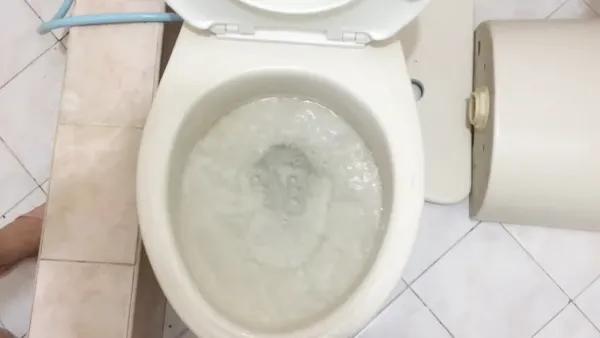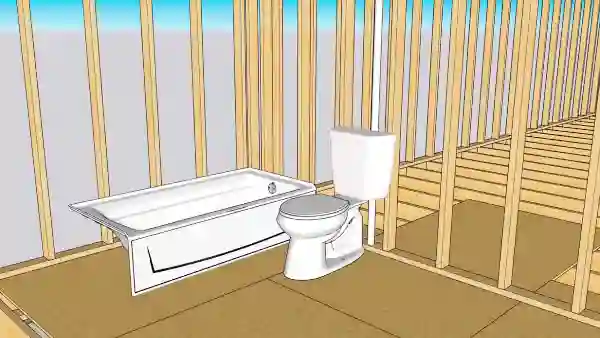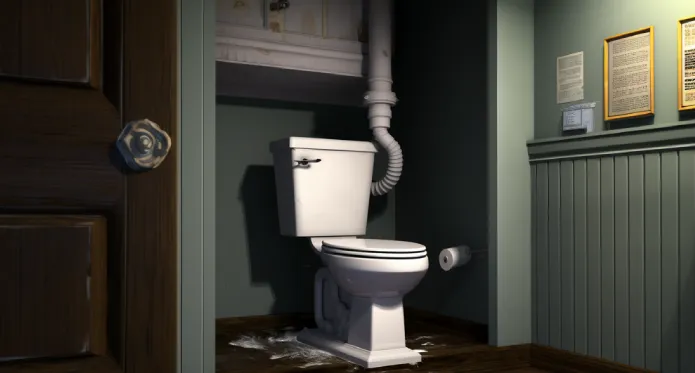Last Updated on November 14, 2023
Slow draining toilets, strange noises, foul odors, or frequent clogs in your plumbing system indicate a lack of venting in your toilets. A toilet needs a vent to ensure proper drainage and prevent sewer gas from seeping into the home.
The venting system in your plumbing plays a crucial role in maintaining the functionality of your toilet. These vents allow air to enter the system, equalizing the pressure and allowing for smooth drainage. Also, vents help to remove foul odors by providing an escape route for sewer gasses.
Today, we’ll explore the importance of toilet venting and what happens when your toilets are not vented. We’ll also discuss the key considerations before venting your toilet to ensure proper waste removal. So keep reading.
What Happens if a Toilet Is Not Vented?

If your toilet is not properly vented, you may experience several issues.
- Slow draining toilet
- Gurgling sounds
- Sewer gas entry
- Trap seal loss
- Toilet bowl issues
- Clogs
1. Slow Draining Toilet
A vacuum effect in the drain pipes can cause the slow-draining toilet. Fusing the toilet without a vent creates negative pressure that slows the water flow. This happens because the vacuum tries to pull air from other openings in the plumbing system, such as nearby sink or tub drains.
As a result, your toilet empties slowly and may take longer than usual to drain fully. The vacuum effect disrupts the smooth flow of wastewater, causing inconvenience and frustration for you as a user.
2. Gurgling Sounds
When you hear gurgling sounds from your toilet plumbing fixtures, it’s a sign that there may be a blocked or inadequate vent. These sounds occur when air cannot properly enter the pipes due to an obstruction in the vent system.
When the vent becomes blocked or insufficient, air tries to find alternative paths, often through water in toilets or traps beneath sinks and tubs. This results in the gurgling or glugging sound you may be experiencing.
3. Sewer Gas Entry
Without proper venting, sewer gasses will likely enter your living space. Water drains without the necessary air pressure can create a vacuum effect. This suction-like force may siphon water out of the toilet trap, causing a space for sewer gasses to enter through.
These sewer gasses contain harmful substances like methane and hydrogen sulfide, which can cause nausea, headaches, and even respiratory problems in high concentrations.
4. Trap Seal Loss
Trap seal loss occurs when the water in the trap is siphoned out due to a blocked vent. This can happen when there is a clog or obstruction in the vent pipe, preventing air from entering and equalizing pressure.
As a result, the negative pressure inside the pipes can force water out of traps, breaking the seal and allowing sewer gasses to enter your home.
5. Toilet Bowl Issues
Insufficient venting can cause fluctuations in your toilet bowl’s water level and air bubbles formation. When there is not enough venting, you may notice that the water in the bowl goes up and down unpredictably. Sometimes, it may be too low, while others, it could be too high. This can be quite frustrating and inconvenient.
Also, inadequate venting can lead to air bubbles rising from the toilet bowl. This is especially common when other appliances like a clothes washer are installed nearby. The proximity of these appliances can disrupt the drain line’s pressure balance, resulting in air bubbles forming.
6. Clogs
When a vent is blocked, a vacuum disrupts the proper wastewater flow through the pipes. This disruption leads to blockages, overflows, and damage to your toilet and other plumbing fixtures.
The blocked vent prevents air from entering the pipes, causing water to drain slowly or not at all. As a result, waste accumulates and can cause difficult clogs to clear without addressing the underlying issue of the blocked vent.
What to Consider Before Venting a Toilet?
Before venting a toilet, there are several key points to consider:
1. Toilet’s Drain Size
The minimum drain size for a toilet is typically 3 inches, determined by plumbing codes and crucial for proper waste removal. This size ensures that the toilet can handle the volume of waste and prevent clogs.
A larger drain size allows for better flow and reduces the likelihood of blockages. It is important to follow your local plumbing code, as some areas may have specific requirements for drain sizes.
2. Trap Arm Length
Trap arms connecting the trap to the vent are important for proper draining and preventing sewer gas from entering your home. In some jurisdictions, the length of the trap arm is regulated by local plumbing codes.
In IPC jurisdictions, there are generally no limitations on trap arm length. However, in UPC jurisdictions, it is commonly limited to 6 feet. To ensure compliance with regulations, you need to measure from the face of the closet flange to the inner edge of the vent opening.
3. Venting Patterns
Venting patterns ensure proper drainage and prevent unpleasant odors from entering your home. One common venting pattern is the vertical vent, where a pipe is installed vertically, extending from the plumbing system to the roof. This allows air to flow freely and maintain equal pressure within the pipes.
Another option is the horizontal vent, which connects to a vertical stack before extending horizontally through an exterior wall. This pattern works well when there are space constraints or when installing a vertical vent is difficult.
4. Installation Constraints
Installing a toilet’s venting system may be challenging due to physical constraints within your home. Following the venting pattern described in the article might be tough without visible pipes if you want to install the system on the second floor.
Also, other factors, such as limited space or existing plumbing configurations, may further complicate the installation process. It is essential to carefully assess these constraints before modifying your toilet’s venting system.
How far away can a vent pipe be from a toilet?

The vent pipe for a toilet should be no more than 6 feet away from the trap. This distance is crucial for the proper functioning of the vent system. Positioning the vent within 6 feet of the trap ensures it effectively serves its purpose.
If the vent pipe is too far away, it may not provide sufficient ventilation, resulting in plumbing issues such as gurgling sounds or sewer odors in your home.
Can a toilet and shower share the same vent?
A toilet and shower can share the same vent if the toilet is the last fixture connected to it. This means that in a bathroom group where a shower and a toilet are wet-vented, the shower can be connected to the same vent pipe as the toilet.
However, remember that the toilet must always be the final fixture connected to the vent. When multiple fixtures are being vented wet, such as a sink, shower, and toilet, all connected to one vent pipe, the toilet’s waste flow must be uninterrupted.
Ensure Smooth Flow and Prevent Problems With Proper Toilet Ventilation
Every toilet in your home needs to have a vent. Without proper ventilation, problems such as slow draining, gurgling sounds, and even sewage odors in the bathroom can arise.
Venting allows air to enter the plumbing system, aiding in the smooth flow of waste and preventing pressure buildup. Before venting a toilet, factors like distance from other fixtures and local building codes must be considered.
Keep in mind that sharing a vent between a toilet and shower is possible but requires careful planning to ensure proper functionality. So pay attention to the importance of a well-vented toilet.

